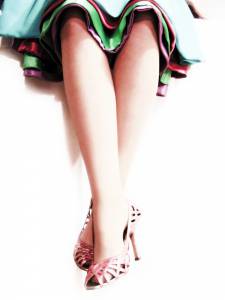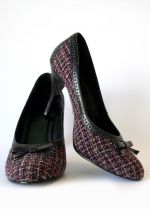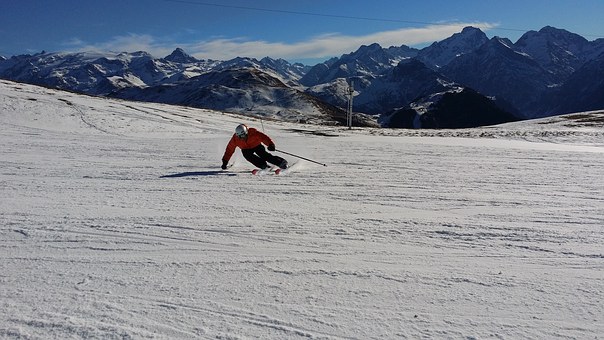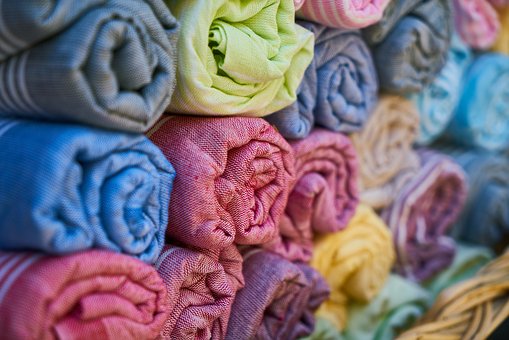For years, women wearing high-heeled shoes have been noted for their appealing posture and gait. Physics and recent scientific research explain exactly what role these tall shoes have in creating the infamous high-heeled gait, or strut. Unfortunately, the dynamics behind these shoes also explains the pain associated with wear. New shoes are now being designed that will help mitigate the negative effects of the physics behind these shoes.
Introduction
Supermodels are known for their provocative struts down the catwalk. This appealing gait requires short bouncy strides, toes pointed to the ground, and hips thrust forward. There is no doubt that those who have perfected this walk have talent, but just like many athletes, their performance requires a small aide – a good shoe (see Fig. 1). This shoe is the high-heel, and a new breed has been engineered because, as every lady knows, a long night in heeled shoes results in sore feet. The root of all the aches and pain is that attractive walk. A detailed look into the physics and experimental data of walking in tall shoes describes how a shoe changes the way someone stands and walks. It turns out that the supermodel strut is basically a reaction of the body trying to maintain balance because of a shift in the body’s center of gravity.
Stance
When standing in high-heeled shoes, posture changes so that the back is arched, the pelvis and chest are thrust forward, the buttocks sticks out, and the calf muscles tighten [1]. When standing straight up without wearing heels, the body creates a 90 degree angle with the floor, which is a normal stance. If the body were a rigid column, putting on a pair of heels would force the entire body to tilt forward, and the angle made with the floor would decrease or, in other words, become acute. As heel height increases, this angle would decrease and give the body more slant. However, the body is not a rigid column, so in order to wear high-heels and maintain a normal stance, a series of joint adjustments is required [2]. The body’s adjustment to this change in angle creates the classic, curved high-heeled stance.
Upper Body
These joint adjustments are a reaction to the way high-heels cause a person’s center of gravity to shift. As heel height increases, the location of the center of gravity is elevated. This shift in height causes a rise in potential energy. (The most stable stance for a person is one that minimizes potential energy.) So, as heel height increases, stability decreases. Humans can control their stability by changing their stance and body position [3]. Thus, “a woman wearing heels increases the sway of her back to maintain her balance” [1]. This added arch in the back then causes the thrust of the chest, pelvis, and posterior.
Lower Body
Long, muscular legs are a heeled shoe’s main effect on the lower body. Their muscularity is due to the inclination of the shoe from heel to toe. This slant is the cause of the decrease in stance angle, as previously discussed. As this angle decreases with the height of the shoe heel, the slope becomes steeper, so the heel of the foot has to raise more. The Achilles tendon is then forced to shorten, which causes the calf muscles to increasingly flex. Thus, the shoe slant causes some muscles of the leg to remain flexed while the added height to the leg gives an illusion of longer legs, both of which are important contributions to the classic heeled shoe stance.
Gait Cycle
The alteration in stance induces a change in gait. A normal walking cycle consists of a three-part sequence. The cycle begins with the heel coming into contact with the floor, which is known as contact. The rest of the foot is gradually brought down until it is flat on the ground, as in a normal stance. This phase is midstance. Then the foot progressively rolls pressure towards the ball so the heel raises up, which is known as push off. These three steps switch back and forth between feet to produce a fairly smooth stride [4].
Bounce
During normal stance, body weight is spread evenly from the heel and ball of the foot. So, the center-of-pressure (COP), which is the average location on the foot where the most weight is distributed, is located in the middle of the foot. When standing in a heel, the acute angle causes the body’s weight to shift forward, so that the center of pressure moves toward the ball of the foot. On a high heel, 90% of the weight is focused on the ball of the foot.
When walking in heels, the COP’s location at the ball causes the contact phase to be felt mostly by the ball and the push-off phase is performed almost entirely from the ball [2]. This transforms the smooth step sequence into a more “jerky” stride. (Picture the difference between a ball that is bounced rather than rolled.) When rolling the ball, there is a smooth transition between different parts of the ball touching the ground, just like shifting between steps of the normal gait cycle. However, when the ball is bounced, one spot is continuously hitting the ground and feeling most of the impact, similar to the ball of the foot in a heeled shoe. Just like the basketball, having the contact phase felt by mostly one section creates a walk with some bounce to it.
Speed
Each gait cycle in a heeled shoe is faster than cycles in flat ones because of the shift in the center of gravity. “To initiate a walking step, you lean forward until you lose your stability. You begin to fall forward, and you step with one foot to catch your fall and reestablish your stability” [3]. Because a shift in center of gravity makes a person less stable in heels, stability is lost more quickly when walking in high-heels, so you have to ‘catch your falls’, or take steps, more often. Research at Sungkyunkwan University’s School of Mechanical Engineering revealed that the period of one gait cycle is cut in half when wearing high-heels instead of flat shoes. More gait cycles are covered in a given distance, so someone walking in heels has very quick steps that cover a short distance.
Sway
Aside from the quick, bouncy steps, the supermodel walk needs showy hip swaying, better known as a sashay. Once again, the shift in center of gravity is the main cause of this action. Pelvis and hip movement contribute greatly to maintaining balance and standing posture by exerting continuous muscular action to ensure equilibrium [5]. When walking in heels, the muscular action taken is turning the hips and pelvic region more, scientifically known as torque.
That’s all there is to it – the classic strut down the catwalk is basically the body trying to keep itself balanced. The hip swaying, swift bouncy strides, and prominent stance are all in reaction to a shift in centers of gravity or pressure. The illusion of muscular legs, on the other hand, is a result of positioning of the heel of the foot.
Negative Effects
A lot of work has to be put into wearing heeled shoes, which makes the attraction of wearing them not so appealing to the body. The arched back brought on by the heeled shoe alters the positions and angles at which joints are allowed to move. The pelvic and abdominal organs must adapt to these positions, which puts strain on the body. The high amount of pressure focused on the ball of the foot adds stress to the ball. Even the heel experiences strain. When walking in four inch heels, the force on the heel of the foot is equivalent to the force felt when running. The way the heel creates the look of long, muscular legs actually takes away from the propulsive power of tendon and leg muscles. This power has to be taken from somewhere else, so knees, thighs, hips, and buttocks are strained.
Hybrid Heels
Luckily, there has been a response to the pain of walking in heels. Shoemakers have come up with a less painful design by integrating technology already found in athletic shoes. Recently, high-heeled shoes were released with pouches of gas similar to those found in running and basketball shoes. These air bags are made from “two layers of fabric connected by thousands of fibers. The fabric layers are surrounded by pressurized gas and encased in and attached to a flexible plastic capsule” [6]. These pockets distribute weight more evenly across the shoe, so the shift in center of gravity, as previously discussed, is minimized. They are inserted in the heel and under the front sole in a variety of hybrid high heels in order to counterbalance pressure put on the ball of the foot while walking and on the heel of the foot while standing [4].
Now, some might wonder why it would be beneficial to buy these shoes when inexpensive gel cushions can be used. One obvious reason is that inserts can be seen if the shoe does not enclose all sides of the foot. The best reason, however, is that the air bags do not erode. When compressed by a footfall, the capsule compresses and then springs back into shape to provide cushioning and absorb shock from the next footfall. So, in addition to being comfortable, these shoes are attractive and durable. Hybrid heels will not completely rid all the strains caused by high heels, but they are a start. “There’s still a lot of room out there for development,” says Karen Mickle, a PhD student at the University of Wollongong’s Biomechanics Research Laboratory [6]. Footwear scientists predict many more advances in heeled footwear are on the way.
Conclusion
High-heeled shoes are a classic way to enhance appearance because they create a classic poise and walk. They are able to transform the body to move in a provocative way mainly because they shift the center of gravity and cause the body to use more muscle and movement to maintain balance. Women have forever been complaining about the way these shoes make the body ache, so innovations are finally being made to high-heeled shoes, although no solution has yet been found to completely rid all the strains of wearing these tall shoes. Engineering comfortable heels could turn out to be problematic since it may require alterations of the classic high-heel design that has been around for the past 50 years. Still, it is a step forward in the world of shoe engineering to move away from the athletic department and into an untouched fashion zone.





